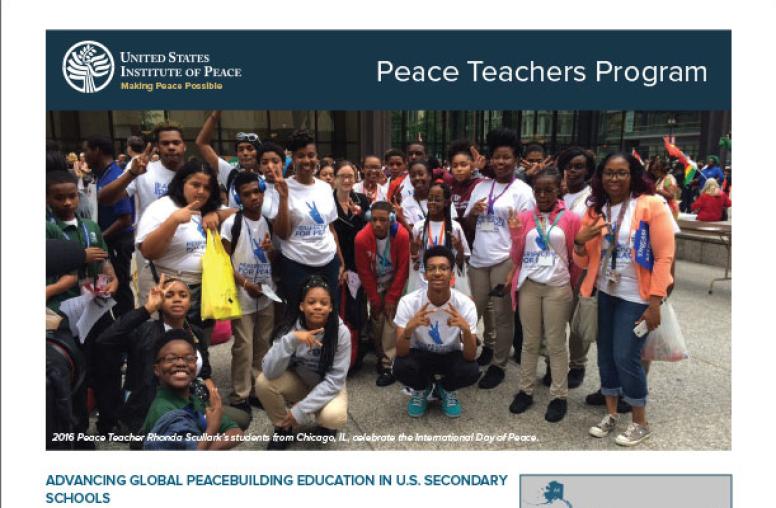The last year was marked by disruption, with schools shuttered, workplaces closed and so many aspects of daily life altered by the pandemic. While COVID drastically reduced the number of tourists to the capital, too, that did not stop USIP from bringing Washington, D.C. to Americans through virtual options for visiting and experiencing the Peace Trail on the National Mall. The Peace Trail brings a “peace lens” to the experience of visiting the National Mall — elevating stories of key figures, institutions and moments in history that demonstrate America’s commitment to peace.

Launched in 2017 as a self-guided walking tour and developed in collaboration with the National Park Service and the local Guild of Professional Tour Guides, the Peace Trail is anchored at the Institute’s headquarters at 23rd and Constitution Avenues Northwest. The trail traces a path to a dozen other sites, many of them honoring sacrifices made throughout the country’s history, highlighting themes of peace and conflict, such as reconciliation, nonviolent action and cooperation. This USIP resource is rooted in the Institute’s commitment to educating the American people about peace, a core part of its founding mandate from Congress.
From the three, pre-pandemic years of sharing the Peace Trail resources with Americans visiting the nation’s capital, USIP knew well that those audiences valued this resource and narrative. “After leaving our meeting at [USIP] … I walked the Peace Trail and followed the entire route, stopping at each site that was on the map… walking the Peace Trail that day and considering a different perspective of those sites, based on your good educational content. That story is important,” said a visitor from Hawaii in 2017. In fact, the Peace Trail had been awarded the Tourism Industry Contribution Award by the Guild of Professional Tour Guides of Washington, D.C. in 2018 for the value it brought to the Guild’s members and to the touring public.
The Virtual Peace Trail
The constraints of the pandemic over the past year prevented millions of tourists from visiting Washington, D.C. Annual school trips were cancelled; summer tour groups stopped operating; even locals stuck closer to home.
But USIP was committed to finding new ways to deliver this content, and was encouraged by conversations last spring with partner organizations and educators who shared an eagerness for the content, and for virtual programs that were engaging and dynamic.
So, the Institute created a virtual reality version of the Peace Trail that anyone could access, and a version that was offered as a live and interactive educational program over Zoom.
Not only did these virtual versions reach would-be visitors, they also connected with Americans — who for a variety of reasons — wouldn’t typically come to D.C. “I really like this format because a lot of these kiddos have never traveled outside of the area of Huntsville, Alabama. It gave them more perspective on things, and they’re excited to visit one day. We did talk a lot about peace and what it means in their daily lives and on a larger scale,” said an educator from Ridgecrest Elementary School in Alabama after their class experienced the virtual Peace Trail program.
Even longtime annual visitors who experienced the Peace Trail on the National Mall firsthand had good things to say about its virtual counterpart. For over five years, eighth graders from Ruffing Montessori School in Ohio had been coming to USIP as part of their annual field trip. The first time the principal experienced the Peace Trail in person, she said, “After two decades of visiting Washington, D.C. with my classes, the Peace Trail was a game-changer. It reframed my students’ experience of visiting iconic sites on the National Mall and enabled us to focus on the United States’ historic commitment to peace.” This year, Ruffing Montessori was eager to experience the Peace Trail virtually, and the teacher later reiterated appreciation to USIP for highlighting this content and some of the same concepts they had been discussing in class.
In a year marked by racial reckoning, intense political polarization, and staggering losses due to COVID, the themes the Peace Trail highlights resonated with communities in deeply personal ways. For many, it was more than just a virtual tour experience — it was a reminder that, as a nation, the United States has experienced great periods of upheaval before and has emerged renewed. The national network of the American Committees on Foreign Relations, which has members in a dozen states mostly in the heartland, experienced the virtual Peace Trail program during this period and noted especially its resonance during a difficult year, describing the experience as “inspiring.”
The nation’s capital is beginning to see in-person visitors again, which means the self-guided resources, like the print-outs of the Peace Trail content (like the Reference Guide and the Activity Kit) and the apps on the Apple Store or Google Play Store, are again practical for tourists. At the same time, USIP continues to offer the virtual versions to those groups not yet ready to venture among the crowds or looking for at-home opportunities to visit Washington, D.C.
With audiences spanning fourth graders to retirees, from classrooms to civic organizations, the Peace Trail on the National Mall remains an ever relevant and informative resource.
Groups interested in the virtual program version can submit a request using this form.



